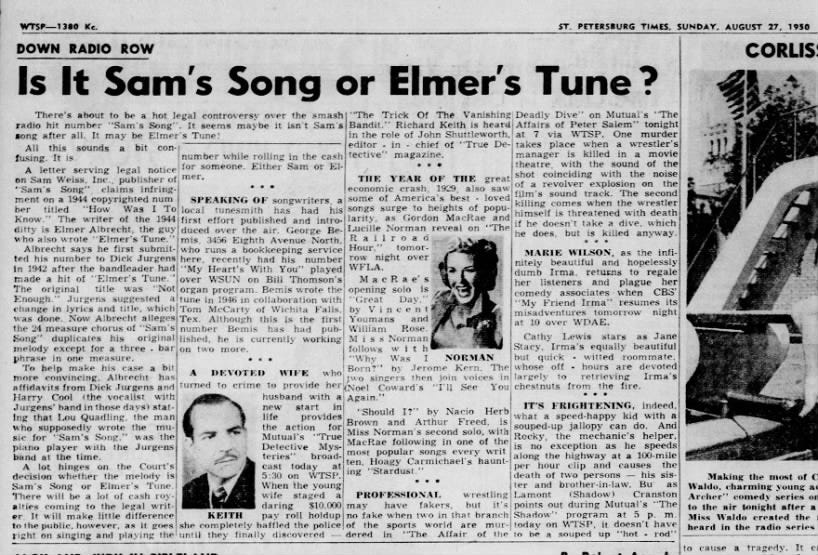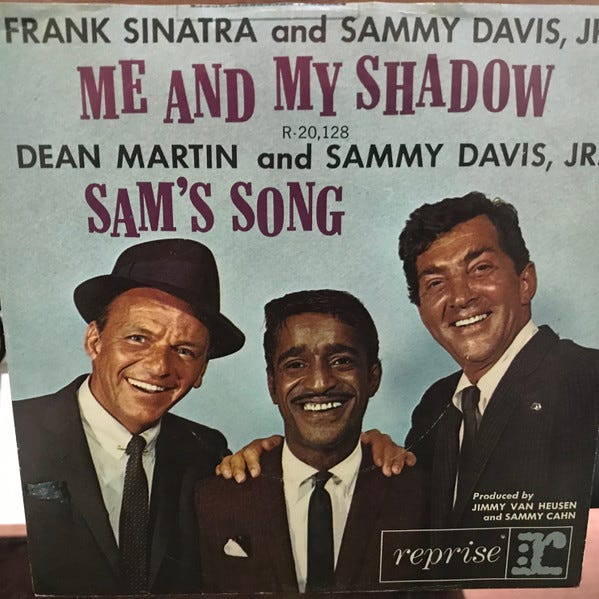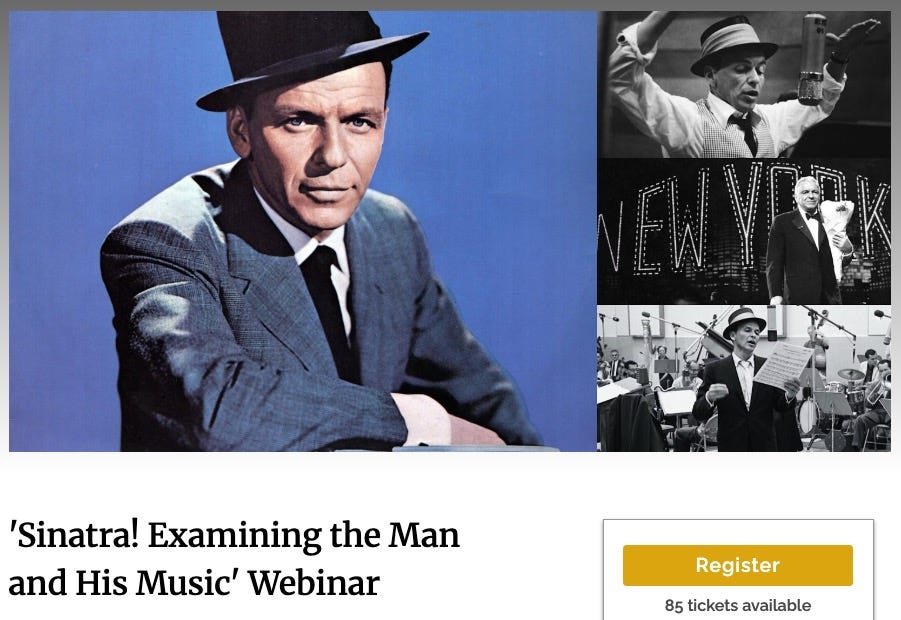75 Years of "Sam's Song"
Or, "Still Happy After All These Years" (featuring the X-Rated version!)
In case you missed it, here’s my interview with Seth MacFarlane, and three recent stories and postings relating to his fine new album, Lush Life: The Lost Sinatra Arrangements.
The Wall Street Journal (June 14, 2025)
Substack 1 - “Shadows / No More Shadows”
Substack 2 - “Hurry Home”
SING! SING! SING!
With Seth McFarlane: “Lush Life: The Lost Sinatra Arrangements”
(SSS #154 2025-06-28)
download: <or> play online:
“Sam’s Song (The Happy Tune)”
Lyrics by Jack Elliott | Music by Lou Quadling
Published by Sam Weiss Music Inc at 1619 Broadway (The Brill Building)
My wonderful friend Bill Boggs reminded me about this one - it’s subtitled “the happy tune” and that, quite literally, is truth in advertising. There are a million documentaries about pop music in the early 1950s that posit “Doggy in the Window” as the definitive example of what was popular in the immediate pre-rock and roll era, but I would suggest that “Sam’s Song” is a much better representation of the kind of relentlessly cheerful, highly musical pop of the Truman and Eisenhower eras, a song that’s at once sophisticated and juvenile, complex harmonically but also you might say, delightfully banal - in the most endearing way.
Lyricist Jack Elliott (1914-1972) wrote several noteworthy songs, of which the best overall is “A Weaver of Dreams” with Victor Young, which Nat King Cole and Nelson Riddle made into a classic; and there are also great versions by Billy Eckstine and Sonny Rollins, among others. (This Jack Elliott is not to be confused with the later composer who used the same name, although he had been born Irwin Elliott Zucker - 1927-2001 - and who wrote mostly for film and television, most famously the theme to Charlie’s Angels.)
The name of composer Lou Quadling (1906-1987) suggests a visitor from the Land of Oz - or at least the UK - but he was apparently born in New Jersey. His other most famous songs were written for and often with the bandleader/singer team of Dick Jurgens and Eddy Howard: “Careless,” which was a hit, “I Do, Do You,” and the lovely “A Million Dreams Ago,” the latter sung magnificently by Sinatra on Point of No Return
.For some reason, even “Sam’s Song” became one of the biggest hits of 1950. Elliott and Quadling did not become a more permanent team - this seems to be their only notable collaboration. (Bing Crosby had actually recorded an earlier song by the team, “Do You Care?” in 1941.)
Perhaps the most notable aspect of the song is that they decided to name it after their publisher, Sam Weiss, proprietor of Sam Weiss Music, one of a zillion firms based in the Brill Building at 1619 Broadway.
Like “Elmer’s Tune,” a 1941 hit for Glenn Miller and his Orchestra, the lyrics to “Sam’s Song” make two distinct points, or maybe one and a half: that these lyrics and this song have absolutely no point other than to tell you to be happy, and, secondarily, that everybody loves this song. It’s at once an endorsement for inner happiness and an advertisement for itself. In a sense, and to employ a uniquely millennial colloquialism, “Sam’s Song” is completely meta.
Regarding ”Elmer’s Tune,” composer Elmer Albrecht wound up naming the song after himself; by contrast, Elliott and Quadling decided to gift their song to their publisher. Coincidentally, there was a legal connection of sorts between the songs and tunes of Sam and Elmer. It turns out that Albrecht started a legal action against Elliott and Quadling, charging that their song was too similar to one of his songs. It was not “Elmer’s Tune,” but rather a 1944 number called “How Was I to Know.” Although that song does not seem to have ever been recorded, Albrecht claimed that Quadling had heard it because they both were working with Dick Jurgens in 1944. (Tampa Bay Times, August 27, 1950, thank you Michael Kraus.)
In traditional pop, singers are the ones usually in the spotlight - songwriters much less so, and publishers even less than that. Perhaps Sam Weiss was so moved by the way Elliott and Quadling devoted their song to his name that it motivated him to work extra hard at plugging the song, and therefore he gave it more attention and promotion than other new songs in his catalog. Perhaps.
The Original Songwriter’s Demo, by Jack Elliott and Lou Quadling
Jack Elliott: “This song, ‘The Happy Tune,’ is written for, and respectfully dedicated to, Sam Weiss. Sam Weiss: sportsman, raconteur, bon-vivant, and the official <unintelligible> of Lucy’s Restaurant. The song we affectionately call ‘Sam’s Song.’ Logical? Lou, if you please.”
As Daniel Weinstein notes, “The actual melody of ‘Sam's Song' has an old-fashioned, vaudeville or ragtime style shape, using half-steps going down and then up. Thus, the ricky-tick staccato approach of the Joe ‘Fingers’ Carr record seems to fit, as does the dixieland interlude on the record of Toni Harper, our lovely and talented young 12 year old vocalist (and what a gorgeous tone her voice has!). Other songs that use this exact same chromatic shape include "Inka Dinka Do" by Jimmy Durante and ‘I Don't Know Enough About You’ by Peggy Lee.’
Joe “Fingers” Carr (Lou Busch), with vocal by The Carr-Hopps (1950)
The first recording was made by pianist and producer Lou Busch in his alter-ego as the honky-tonk pianist Joe “Fingers” Carr. (In other guises, Busch was then the husband of star singer Margaret Whiting and the father of their daughter, Debbie, who today runs the conjoined publishing estate of Busch and Richard Whiting.) I find this version to be very dry compared to the better known Bing & Gary Crosby hit single, even though there is a vocal group joining him. There were at least ten different versions recorded and released around the summer of 1950, but none of them have any of the warmth that the two Crosbys bring to the song - they make a point of sounding like they actually know and love the Sam in question.
Toni Harper with Mannie Klein’s Dixieland Band and the Four Hits and a Miss
On second thought, I couldn’t resist this one, spotlighting the very accomplished and very lovable tween vocalist Toni Harper - who at 12, was even younger than Gary Crosby.
Gary Crosby and Friend, with Matty Matlock’s All-Stars (1950)
This is the version that most of us know and love, and the story of how it was made has become almost as iconic as the disc itself. As Gary Crosby told the tale, it was four days before his 17th birthday, when his father told him that they were going to spend the summer off in the woods hunting and fishing, which, as is well known, was just about Bing Crosby’s favorite thing in the world. But on their way out of town, they were just going to stop briefly in at the Decca studios in Los Angeles, and quickly cut a single. There, they recorded two duets with rather unusual contrapuntal patter sections, Irving Berlin’s rather deceptively-titled 1914 “Play a Simple Melody” and the new “Sam’s Song.” Then, they disappeared into the forest primeval for a few weeks; when they got back, Gary discovered, to his extreme surprise, that their version of “Sam’s Song” was the biggest thing in the country. It launched a set of duet discs between father and son.
Among other things, their recording is apparently the first to feature the contrapuntal patter chorus, which played a big part in making the track a hit. And it’s also said that the Bing / Gary version of “Simple Melody” reminded Berlin of his own song, and inspired him to write a new contrapuntal song for Call Me Madam, the new musical he was working on in the summer of 1950, which as we all know became the even more successful “You’re Just In Love.”
Bing:
Here’s a happy tune you’ll love to croon
They call it Sam’s songIt's catchy as can be, the melody
They call it Sam’s songNothing on your mind
And then you’ll find you’re humming Sam’s SongWhy, it makes you grin
Gets under your skin as only a song can doPeople that you meet out on the street
All whistling Sam’s SongEveryone you see will soon agree
That it’s a grand songSo forget your troubles and wear a smile
You’ll find you never go wrong
If you learn to croon this happy tune
They call it Sam’s songspoken: “And now another treatment of this Classic American Theme, brought to you by Mr. Gary Crosby”
Bing and Gary (Gary in parenthesis):
Here’s a happy tune
(That’ll bring you a smile all the while)
(When you croon it you’re really in style)
And the title is Sam’s SongIt’s catchy as can be
(With a sly little beat)
(And the melody sweet keeps you tapping your feet)
And the title is Sam’s SongNothing on your mind
(But the news of the day)
(And the bills you must pay keep your hair turning gray)
(But you’re still humming Sam’s Song)Bing: “Are you alright?”“How’s your brace”
(Why, it makes you grin)
(Gets under your skin as only a song can do)People that you meet
(Hello Joe, what you know)
(And remind me to Moe, tell him business is slow)
(But I’m whistling) Sam’s SongEveryone you see
(Has a story to tell or a gimmick to sell)
(But agree that it’s swell)
(And it’s really)
A grand songSo forget your troubles and wear a smile
You’ll find you never go wrong
If you learn to croon
(Like a lark in the park)
Who is making his mark serenading the dark
With a chorus of Sam's song
If you learn to croon the happy tuneThey call it Sam’s song
Bing and the King (1951) (live radio)
Following the Gary/Bing blockbuster, both partners made memorial duets with other superstar collaborators - Bing with Nat King Cole and Gary with Sinatra. The Bing-Nat combination is especially sweet in that it is not the only time they crossed paths; as Gary Giddins shows in Bing Crosby: Swinging on a Star: The War Years, 1940-1946, Crosby was aware of the King Cole Trio as early as 1940. This is the only time they worked together, and a swell duet it is. Just as, as Gary also notes, Crosby was the only one to address Louis Armstrong directly as “Lou,” he’s also the only one to call Nat “King.” In any case, their affection for each other is highly evident here in this radio performance broadcast from February 28, 1951, especially their banter around the patter chorus - which Nat carefully rehearsed even though he also obviously sang with a lyric sheet in front of him.
Frank Sinatra & Gary Crosby, on The Summer Show, August 15, 1954
To me, this is also fun, even very fun - Gary sings his part and Sinatra sings Bing’s part - and Gary even does a Phil Silvers impression at the start. Gary and his brothers had guested on the first episode of Sinatra’s Old Gold show in 1945, and now, a decade or so later, Sinatra is returning the favor. Again, they at least sound like they’re enjoying the song and each other’s company. It’s from The Summer Show, hosted by Gary, as wisely selected - and then expertly remastered - by Chuck Granata for the highly-recommended Sony Music package, Frank Sinatra: A Voice on Air (2015). Yes!
The Parodies - one playable on the air, the other not so much:
This is more in the wheelhouse of Mickey Katz, who specialized in yiddishkeit parodies of current popular hits, more so than Allan Sherman, who a decade later catapulted to fame with hamish versions of folk songs - I guess capitalizing on the essential truth that vast numbers of folk singers during the boom of the 1960s were Jewish. This 1951 parody follows the “Gary Crosby and Friend” arrangement rather closely; the flipside was another 1950 hit, “A Bushel and a Peck” from Guys and Dolls. Sylvia Froos sings the female part on the Frank Loesser song, but I confess I don’t know who sings the role of “Jake” with Sherman on “Jake’s Song.”
Mitch Miller and Percy Faith
Back in the 1980s, my dear friend and mentor James Maher - best remembered for his work on Alec Wilder’s famous tome, American Popular Song - told me about this track, which he had owned on a privately-pressed 45 RPM single some 20 or 30 years before that. Even after all those decades, he still remembered all the lyrics - and no, I’m not going to transcribe them here, but it starts with:
Here’s a piece of sh*t
Became a hit
They call it “Sam’s Song.”
Published by a schmuck
Who fell in luck
By pushing “Sam’s Song”
And that’s about all that I can actually quote! Knowing Jim, he was probably in the studio with Mitch Miller and Percy Faith when they recorded this surreptitiously around 1951. For years I doubted I would ever get to hear it, but sometime in the 1990s, the highly accomplished collector / researcher / archivist / historian Bob Conrad told me about a curious thing he had found, on a radio transcription; he described it as “two old guys who can’t sing doing a blue version of ‘Sam’s Song.’” When he played it for me, I recognized Mitch’s voice immediately, and I also sent a tape to Mitch, who enjoyed hearing it again. It’s still never been issued anywhere, although I included it on a home-toasted Christmas compilation a while ago. It occurs to me that more people will now (hopefully) hear it via Substack - in all its grungy glory - than ever before in the last 75 years.
Sammy Davis Jr. and Dean Martin (including the live version, in which you’ll hear, “tell you what I’ll do / since you’re a Jew” in place of “since I’m with you”)
In 1962 - at the height of what was later known as the “Rat Pack Era” - Sinatra conceived a unique project for his two closest singing compadres, Sammy Davis, Jr., and Dean Martin. He put the spotlight on Davis at the center of two elaborate updates of traditional duets: “Me and My Shadow” by himself and Sammy, and “Sam’s Song” by Dean and Davis. Both tracks were considerably modernized via extra-spiffy, very modern, hard-swinging arrangements by Billy May and new lyrics by “rat pack poet” Sammy Cahn. The two were released in an even more spiffy picture sleeve as a 45 on Reprise Records - the Trio had already performed them live at the Sands a month or so earlier, and though these were filmed via a one-camera set-up, the early performance of “Sam’s Song” especially is much rougher and less precise than the November studio date. Where some of the Rat Pack material is admittedly dated and has a well-you-had-to-be-there sensibility, these two sides capture the collective at its edgy zenith. (recorded 22 October 1962)
(Very special thanks to Elizabeth Zimmer & Dan Fortune for their expert proofing, hey!)
Coming on Wednesday June 25 @ 7:00PM, THE NEW YORK ADVENTURE CLUB presents 'SINATRA! EXAMINING THE MAN AND HIS MUSIC' webinar (All presentations are available for replay viewing for one week after the live event. For more information & reservations, please click here.)
Sing! Sing! Sing! : My tagline is, “Celebrating the great jazz - and jazz-adjacent - singers, as well as the composers, lyricists, arrangers, soloists, and sidemen, who help to make them great.”
A production of KSDS heard Saturdays at 10:00 AM Pacific; 1:00 PM Eastern.
To listen to KSDS via the internet (current and recent shows are available for streaming) click here.
The whole series is also listenable on Podbean.com; click here.
SING! SING! SING!
With Seth McFarlane: “Lush Life: The Lost Sinatra Arrangements”
(SSS #154 2025-06-28)
download: <or> play online:
LOUIS ARMSTRONG: International Satch (“A Wonderful World”)
(SSS #153 2025-06-21 - 2025 LOUIS ARMSTRONG BIRTHDAY SPECIAL)
download: <OR> play online:
INSIDE ART Dave Drexler interviews Will Friedwald re NIGHTS AT THE RED STEINWAY (2025-06-22)
download: <or> play online:
Father's Day (“My Old Man”)
(SSS #152 2025-06-14)
download: <or> play online:
Nelson Riddle
(SSS #29 2023-01-14)
download: <or> play online:
Let's Spring One! (Sing Sing Sing goes Spring Spring Spring!)
(SSS #149 2025-05-24 - Spring 2025, Part 2)
download: <or> play online:
The Charles Strouse Jazz & Pop Mixtape (RIP 1928-2025)
(SSS #062 2023-09-02)
download: <or> play online:
SLOUCHING TOWARDS BIRDLAND is a Substack newsletter by Will Friedwald. The best way to support my work is with a paid subscription, for which I am asking either $5 a month or $50 per year. Thank you for considering. (Thanks as always to Arlen Schumer for special graphics.) Word up, peace out, go forth and sin no more! (And always remember: “A man is born, but he’s no good no how, without a song.”)
Note to friends: a lot of you respond to my Substack posts here directly to me via eMail. It’s actually a lot more beneficial to me if you go to the Substack web page and put your responses down as a “comment.” This helps me “drive traffic” and all that other social media stuff. If you look a tiny bit down from this text, you will see three buttons, one of which is “comment.” Just hit that one, hey. Thanks!j
Slouching Towards Birdland (Will Friedwald's Substack) is a reader-supported publication. To receive new posts and support my work, consider becoming a free or paid subscriber.











Hey Will -
I was glad to see your salute to "Sam's Song", especially when you talked about the version Bing and Gary Crosby did with Matty Matlock. Matty was a dear friend of mine, my neighbor who lived just across the street from me in North Hollywood in my early days. He was a sweet man and always enthralled me when he talked about working with Bob & Bing C., Jack Webb (Pete Kelly's Blues), Ella, Mel and all the other greats of that era. For a guy so accomplished, he had to be one of the most modest men I ever met - truly one of the good guys. What a legacy he left us! Keep on keepin' on, - Hank/Henry Jones
In the Peggy Lee/Geroge Shearing album“The Beauty and the Beat!” at the instrumental break of If Dreams Come True Shearing delivers his celebrated double melody block chord piano and vibraphone rendition of “Sam’s Song.”